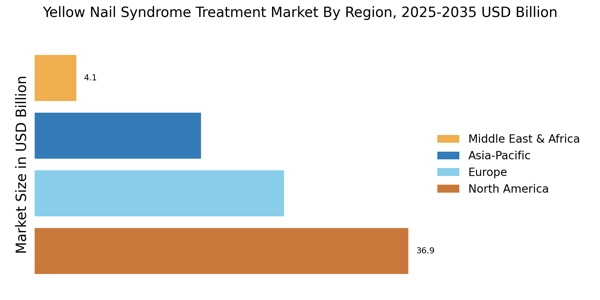Rising Healthcare Expenditure
The increase in healthcare expenditure across various regions is a critical driver for the Yellow Nail Syndrome Treatment Market. As governments and private sectors allocate more resources to healthcare, there is a corresponding rise in funding for research and development of treatments for rare conditions like Yellow Nail Syndrome. This trend is particularly evident in developed economies, where healthcare spending has seen a steady increase, with estimates suggesting a growth rate of around 5% annually. Enhanced funding allows for better diagnostic tools and treatment options, which may lead to improved patient outcomes. Additionally, as more patients gain access to healthcare services, the demand for effective treatments is likely to rise, further propelling market growth. The focus on improving healthcare infrastructure and accessibility is expected to play a pivotal role in shaping the future of the Yellow Nail Syndrome Treatment Market.
Innovative Treatment Modalities
The emergence of innovative treatment modalities is significantly influencing the Yellow Nail Syndrome Treatment Market. Recent advancements in pharmacological therapies, including the use of antifungal agents and immunomodulators, have shown promise in managing symptoms associated with Yellow Nail Syndrome. Furthermore, the development of personalized medicine approaches, which tailor treatments to individual patient profiles, is gaining traction. This shift towards more effective and targeted therapies is likely to enhance patient outcomes and satisfaction. Market data indicates that the segment for novel treatment options is expected to grow at a compound annual growth rate of approximately 6% over the next five years. As healthcare providers continue to explore and implement these innovative solutions, the market is poised for substantial growth, driven by the demand for more effective treatment strategies.
Growing Patient Awareness and Advocacy
The growing awareness and advocacy surrounding Yellow Nail Syndrome is a significant driver for the Yellow Nail Syndrome Treatment Market. Increased efforts by patient advocacy groups and healthcare organizations to educate the public about this condition have led to a rise in early diagnosis and treatment. As patients become more informed about their health, they are more likely to seek medical advice and treatment options. This trend is reflected in the increasing number of online resources and support networks dedicated to Yellow Nail Syndrome. Furthermore, the rise of social media platforms has facilitated the sharing of personal experiences, which may encourage others to seek help. This heightened awareness is likely to contribute to a larger patient population seeking treatment, thereby driving market growth. The emphasis on patient education and empowerment is expected to shape the future landscape of the Yellow Nail Syndrome Treatment Market.
Technological Advancements in Diagnostics
Technological advancements in diagnostic tools are playing a crucial role in the Yellow Nail Syndrome Treatment Market. The development of more sophisticated imaging techniques and laboratory tests has improved the accuracy of diagnosing Yellow Nail Syndrome. Enhanced diagnostic capabilities enable healthcare professionals to identify the condition earlier and more effectively, which is essential for timely intervention. Recent innovations, such as digital health technologies and telemedicine, have also facilitated remote consultations and monitoring, making it easier for patients to access care. Market data suggests that the diagnostic segment is projected to grow at a rate of approximately 7% over the next few years, driven by these technological advancements. As diagnostic accuracy improves, the likelihood of effective treatment increases, thereby positively impacting the overall market dynamics for Yellow Nail Syndrome treatment.
Increasing Prevalence of Yellow Nail Syndrome
The rising incidence of Yellow Nail Syndrome is a notable driver for the Yellow Nail Syndrome Treatment Market. As awareness of this condition grows, more individuals are seeking medical attention, leading to an increase in diagnosed cases. Recent estimates suggest that Yellow Nail Syndrome affects approximately 1 in 10,000 individuals, with a higher prevalence noted among older adults. This demographic shift, combined with an aging population, is likely to contribute to a growing patient base requiring treatment. Consequently, healthcare providers are increasingly focusing on developing targeted therapies and management strategies, which may further stimulate market growth. The increasing prevalence of associated conditions, such as respiratory diseases and lymphedema, also underscores the need for effective treatment options, thereby enhancing the overall market landscape.


















Leave a Comment